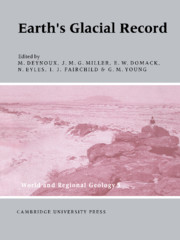Book contents
- Frontmatter
- Contents
- List of contributors
- Preface
- Acknowledgements
- 1 Geodynamic controls on glaciation in Earth history
- 2 Glacial-marine facies in a continental rift environment: Neoproterozoic rocks of the western United States Cordillera
- 3 The Neoproterozoic Konnarock Formation, southwestern Virginia, USA: glaciolacustrine facies in a continental rift
- 4 Glaciogenic deposits of the Permo-Carboniferous Dwyka Group in the eastern region of the Karoo Basin, South Africa
- 5 Itararé Group: Gondwanan Carboniferous-Permian of the Paraná Basin, Brazil
- 6 The interpretation of massive rain-out and debris-flow diamictites from the glacial marine environment
- 7 Neoproterozoic tillite and tilloid in the Aksu area, Tarim Basin, Uygur Xinjiang Autonomous Region, Northwest China
- 8 Lithology, sedimentology and genesis of the Zhengmuguan Formation of Ningxia, China
- 9 Architectural styles of glacially influenced marine deposits on tectonically active and passive margins
- 10 Marine to non-marine sequence architecture of an intracratonic glacially related basin. Late Proterozoic of the West African platform in western Mali
- 11 The enigmatic Late Proterozoic glacial climate: an Australian perspective
- 12 Isotopic signatures of carbonates associated with Sturtian (Neoproterozoic) glacial facies, central Flinders Ranges, South Australia
- 13 Reactive carbonate in glacial systems: a preliminary synthesis of its creation, dissolution and reincarnation
- 14 A Permian argillaceous syn- to post-glacial foreland sequence in the Karoo Basin, South Africa
- 15 A palaeoenvironmental study of black mudrock in the glacigenic Dwyka Group from the Boshof-Hertzogville region, northern part of the Karoo Basin, South Africa
- 16 Late Paleozoic post-glacial inland sea filled by fine-grained turbidites: Mackellar Formation, Central Transantarctic Mountains
- 17 Ice scouring structures in Late Paleozoic rhythmites, Paraná Basin, Brazil
- 18 Soft-sediment striated surfaces and massive diamicton facies produced by floating ice
- 19 Environmental evolution during the early phase of Late Proterozoic glaciation, Hunan, China
19 - Environmental evolution during the early phase of Late Proterozoic glaciation, Hunan, China
Published online by Cambridge University Press: 06 July 2010
- Frontmatter
- Contents
- List of contributors
- Preface
- Acknowledgements
- 1 Geodynamic controls on glaciation in Earth history
- 2 Glacial-marine facies in a continental rift environment: Neoproterozoic rocks of the western United States Cordillera
- 3 The Neoproterozoic Konnarock Formation, southwestern Virginia, USA: glaciolacustrine facies in a continental rift
- 4 Glaciogenic deposits of the Permo-Carboniferous Dwyka Group in the eastern region of the Karoo Basin, South Africa
- 5 Itararé Group: Gondwanan Carboniferous-Permian of the Paraná Basin, Brazil
- 6 The interpretation of massive rain-out and debris-flow diamictites from the glacial marine environment
- 7 Neoproterozoic tillite and tilloid in the Aksu area, Tarim Basin, Uygur Xinjiang Autonomous Region, Northwest China
- 8 Lithology, sedimentology and genesis of the Zhengmuguan Formation of Ningxia, China
- 9 Architectural styles of glacially influenced marine deposits on tectonically active and passive margins
- 10 Marine to non-marine sequence architecture of an intracratonic glacially related basin. Late Proterozoic of the West African platform in western Mali
- 11 The enigmatic Late Proterozoic glacial climate: an Australian perspective
- 12 Isotopic signatures of carbonates associated with Sturtian (Neoproterozoic) glacial facies, central Flinders Ranges, South Australia
- 13 Reactive carbonate in glacial systems: a preliminary synthesis of its creation, dissolution and reincarnation
- 14 A Permian argillaceous syn- to post-glacial foreland sequence in the Karoo Basin, South Africa
- 15 A palaeoenvironmental study of black mudrock in the glacigenic Dwyka Group from the Boshof-Hertzogville region, northern part of the Karoo Basin, South Africa
- 16 Late Paleozoic post-glacial inland sea filled by fine-grained turbidites: Mackellar Formation, Central Transantarctic Mountains
- 17 Ice scouring structures in Late Paleozoic rhythmites, Paraná Basin, Brazil
- 18 Soft-sediment striated surfaces and massive diamicton facies produced by floating ice
- 19 Environmental evolution during the early phase of Late Proterozoic glaciation, Hunan, China
Summary
Abstract
Glacial rocks of Late Proterozoic age are widely distributed in South China and two glacial epochs are recognized. The epochs are the earlier Dongshanfeng and the later Nantuo, separated by the Datangpo interglacial epoch. The Dongshanfeng epoch is named after the Dongshanfeng Formation found in the Sinian section in the Yangjiaping Area, Shimen County, Hunan province. It was previously thought that the sequence below the lower boundary of the Dongshanfeng was preglacial and was deposited under warm climatic conditions. Recently several possible peri- and proglacial environmental indicators along the lower boundary of the Dongshanfeng Formation and in the top 60 m segment of the underlying Xieshuihe Formation have been discovered. These are ice-keel scoured ridges, dropstones with compressive concave morphology, ice-wedge casts, glacier meltwater-cut grooves, and glaciotectonic thrust structures. The first three are indicative of periglacial environments, and the rest record proglacial conditions.
Based on the stratigraphic order of the above mentioned structures, a depositional model for the Yangjiaping Area during the preceding stage or the early stage of the Dongshanfeng Epoch is proposed. The major controls on deposition were the gradual lowering of temperature and sea-level, the thickening and expanding of an ice-sheet, and the change from a submarine to subaerial setting. Later, due to crustal loading below the ice-sheet, the Yangjiaping Area once again became submarine and accommodated the glaciomarine Dongshanfeng Formation.
The structures described herein are of particular significance because most glacial stratigraphic records fail to show indications of the climatic transition from warm to cold as a result of glacial erosion. The sparse records of the preceding stage of Nanhua Ice Age found in Yangjiaping are, therefore, of special significance.
- Type
- Chapter
- Information
- Earth's Glacial Record , pp. 260 - 266Publisher: Cambridge University PressPrint publication year: 1994
- 2
- Cited by

